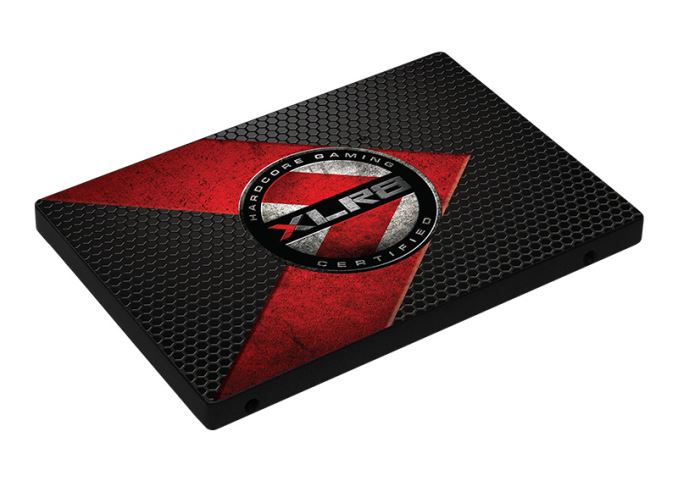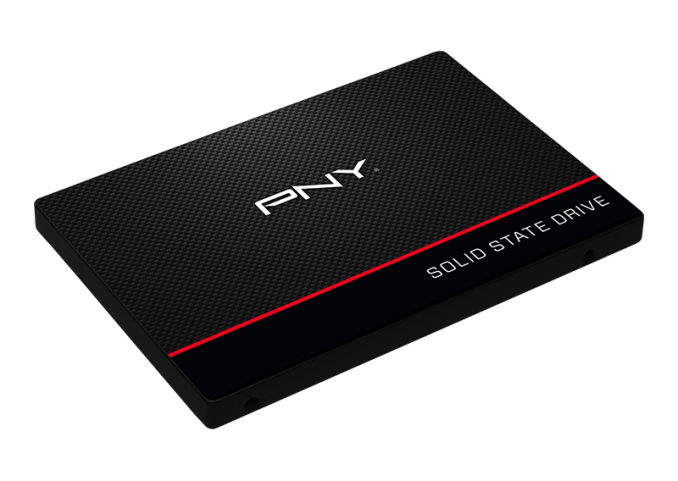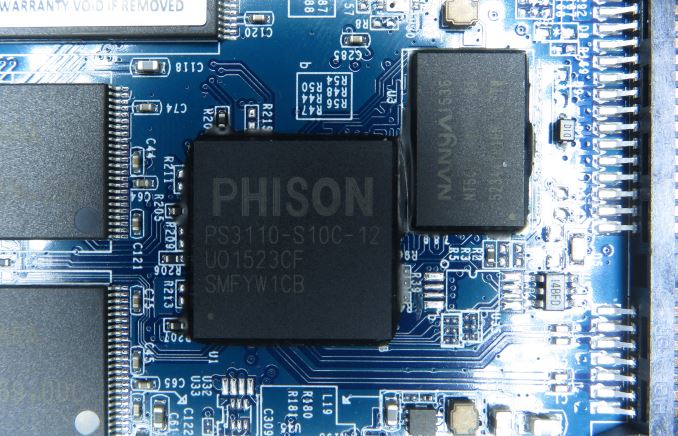The PNY CS1311 and CS2211 SSD Review: MLC vs TLC at 15nm
by Billy Tallis on April 15, 2016 8:00 AM EST
Phison's S10 SATA SSD controller has taken over a large chunk of the SSD market. It works with both MLC and TLC and is sold as part of an off-the-shelf SSD solution that allows companies to purchase complete drives with the controller, NAND (from Toshiba), and firmware, awaiting only branding. Many companies that formerly developed and manufactured their own drives based on controllers from the likes of SandForce have switched over to Phison's platform, saving lots on R&D but sacrificing almost all opportunities for product differentiation. The most recent entrants in the SSD market only came into being because Phison made it so accessible. Even Toshiba, with their large resources, has adopted the Phison S10 as the heart of their TC58 controller used in the Q300 and OCZ's Trion product line.
The latest member to join the Phison legion - and the subject of today's review - is PNY. PNY's latest refresh of their consumer SSDs has shifted their product lines entirely over to the latest iteration of Phison S10 platform. In focusing their lineup around the S10 platform, the company has introduced two new drives: the CS1311 and the CS2211. The CS1311 is the entry-level model of their refreshed lineup and uses Toshiba's 15nm TLC NAND. Meanwhile the CS2211 is the performance-oriented model with their XLR8 (accelerate...) branding, and uses Toshiba's 15nm MLC.
| PNY CS1311 Specifications | |||||
| Capacity | 120GB | 240GB | 480GB | ||
| Controller | Phison PS3110-S10C-12 | Phison PS3110-S10-X | |||
| NAND | Toshiba 15nm TLC | ||||
| Sequential Read | 550MB/s | 550MB/s | 550MB/s | ||
| Sequential Write | 510MB/s | 520MB/s | 520MB/s | ||
| 4KB Random Read | 86K IOPS | 87K IOPS | 90K IOPS | ||
| 4KB Random Write | 90K IOPS | 90K IOPS | 90K IOPS | ||
| Idle Power | 170mW | ||||
| Active Power | 2.2W | ||||
| Warranty | Three years | ||||
| Price (Amazon) | $39.99 | $59.99 | $109.99 | ||
| PNY CS2211 XLR8 Specifications | ||||
| Capacity | 240GB | 480GB | ||
| Controller | Phison PS3110-S10C-12 | Phison PS3110-S10-X | ||
| NAND | Toshiba 15nm MLC | |||
| Sequential Read | 560MB/s | 565MB/s | ||
| Sequential Write | 470MB/s | 540MB/s | ||
| 4KB Random Read | 87K IOPS | 95K IOPS | ||
| 4KB Random Write | 95K IOPS | 95K IOPS | ||
| Idle Power | 200mW | |||
| Active Power | 3.3W | |||
| Warranty | Four years | |||
| Price (Amazon) | $84.96 | $134.96 | ||
As the latest S10 based drives to hit the market, the specifications and expected performance of the CS1311 and CS2211 should not surprise anyone. With very limited room to differentiate through firmware, the two drives should perform very similar to the drives we've looked at in the past.
But unlike other vendors' lineups, PNY's S10-based lineup gives us the interesting opportunity to make a direct comparison between MLC and TLC on the Phison S10 platform. With the same PCBs and the same controller, the CS1311 and CS2211 differ only in the choice of flash and the firmware. This is perhaps our best chance to compare MLC and TLC to date; In the past we've been able to compare Samsung's flash with close relatives like the 850 Pro vs the 850 EVO, but never with two drives quite so similar as the PNY S10 drives. The end result is that although this won't quite be an apples-to-apples comparison since we can't rule out the impact of firmware - the performance and endurance characteristics of TLC means that it's not treated exactly like MLC - but we are nonetheless getting a unique look at NAND performance on identical platforms.
Taking a look at our individual drives then, it is interesting to note that the standard Phison S10 drive has undergone significant physical changes since our first encounter with it via the Corsair Neutron XT. The case still consists of two metal parts that snap together, but they now interlock more at the edges instead of the top piece encircling all four sides. Inside we find PCBs with a familiar layout save for two major changes. As with the transition from OCZ's Trion 100 to the Trion 150, we find that the 15nm NAND is in TSOP packages where the earlier drives with A19nm NAND used BGA packages for the flash.
The bigger change is that the 120GB and 240GB drives are using a smaller variant of the S10 controller. The full-size controller we're familiar with is the PS3110-S10-X, and the newcomer is the PS3110-S10C-12. The S10C has only four NAND channels instead of eight, and the PCB for that variant only has space for one DRAM chip rather than one on each side as found with S10-X. This narrowing of interfaces has the potential to introduce bottlenecks, but this is only being done for the two smallest capacities that would have trouble fully exploiting the parallelism available from the larger controller.
The last hardware change of note is that the controller and DRAM chips on the CS2211 sealed around the edges with a soft potting compound. I'm told this will be rolling out to other S10 products.
Both model lines are priced attractively. Of current-generation drives, the CS1311 competes against the likes of ADATA's SP550 and OCZ's Trion 150, plus lingering supply of older drives with 19+nm TLC NAND. The CS2211 competes against drives like Crucial's MX200, Samsung's 850 EVO, and the various MLC drives with Silicon Motion's SM2246EN controller (eg. Mushkin Reactor, Crucial BX100).
| AnandTech 2015 SSD Test System | |
| CPU | Intel Core i7-4770K running at 3.5GHz (Turbo & EIST enabled, C-states disabled) |
| Motherboard | ASUS Z97 Deluxe (BIOS 2501) |
| Chipset | Intel Z97 |
| Memory | Corsair Vengeance DDR3-1866 2x8GB (9-10-9-27 2T) |
| Graphics | Intel HD Graphics 4600 |
| Desktop Resolution | 1920 x 1200 |
| OS | Windows 8.1 x64 |
- Thanks to Intel for the Core i7-4770K CPU
- Thanks to ASUS for the Z97 Deluxe motherboard
- Thanks to Corsair for the Vengeance 16GB DDR3-1866 DRAM kit, RM750 power supply, Carbide 200R case, and Hydro H60 CPU cooler


















43 Comments
View All Comments
alexdi - Friday, April 15, 2016 - link
I read this with only one question in mind: does it beat the 850 Evo? Save for a few ticks in power usage, apparently not. The Evo is perpetually on sale. I've yet to see a compelling reason to opt for anything else on a desktop.ingwe - Friday, April 15, 2016 - link
Completely agree. I am not tied to it, but I don't see any reason to recommend pretty much anything else.fierywater - Friday, April 15, 2016 - link
The CS1311 gets marked down from time to time; I picked up my 480GB one for $100 while the Evo 850 500GB usually doesn't get marked down below $130 (and it was $150 everywhere when I picked up the CS1311). It's plenty fast for real world use, especially as a drop-in replacement for an HDD. I think there's a place for drives like it, although that applies less to the CS2211.lilmoe - Friday, April 15, 2016 - link
For the performance and value you're getting with the EVO, $30 is well worth the extra, and hardly an amount worth saving going for the CS1311, or any other TLC drives at that. In the matter of fact, lots of the current consumer MLC drives don't compare to the value, performance, or in some cases, the endurance and features you're getting with the EVO.ATC9001 - Monday, April 18, 2016 - link
I agree from most "prosumers" which are frequent to read this article, but for the mainstream user, I don't think its worth it (spending the $30+). Any SSD is better than a HDD, but some garbage bargain bin SSDs aren't worth the cheap price (this being the first exception). I know most people (including myself) think the same thing alexdi posted when reading this....is this going to beat the evo? It doesn't, but at the same time it's not far off from it, and $30 bucks can cause it to break a price plane for some mid range users.Each person has there own utility curve or price performance idea, and for me, this is the first drive since the 840 EVO was released in which I would say it's not worth the x dollars to just get the evo!
Stuka87 - Friday, April 15, 2016 - link
Having a quality, reliable drive is not reason enough for you? If you want to buy a drive that has a much shorter life span, go for it. But Anybody that cares about data, is not going to by a TLC drive over a MLC drive.lilmoe - Friday, April 15, 2016 - link
FYI, TLC VNAND has better endurance than most 15nm MLC drives...Impulses - Friday, April 15, 2016 - link
Define much shorter...You're talking in broad strokes about a bunch of different things in the same breath. Life span and reliability aren't necessarily the same thing, unless you need drives to be reliable for 15yrs...
15yrs ago I was wondering if I'd ever fill my 75GB Deathstar, I'm not sure I'd even keep a drive 5+ years. My 2x 850 EVO have been nothing but reliable since I bought them last year.
DanoSpumoni - Friday, April 15, 2016 - link
Same here. the M.2 850 EVO 500GB is my go to SSD right now. They are in all my computers either in M.2 slots or M.2-> SATA sleds. The performance and reliability is hard to beat. I only buy M.2 SSDs now for future compatibility because they last so long I know they'll outlive the computers they inhabit right now. When the 1TB version drops to ~$150 I'll grab some more...Impulses - Friday, April 15, 2016 - link
I'm sitting on 2x 1TB, bought at like $310 & $330 IIRC, seen them for $260 lately... Waiting for the 2TB to drop lower and I might add one of those. :D